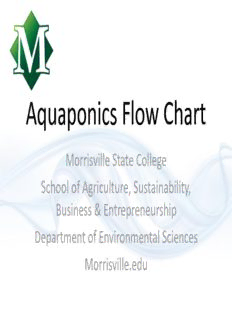
Aquaponics Flow Chart PDF
Preview Aquaponics Flow Chart
Aquaponics Flow Chart Morrisville State College School of Agriculture, Sustainability, Business & Entrepreneurship Department of Environmental Sciences Morrisville.edu Aquaponics flowchart Table of Contents A. Fish B. Plants: Raft System C. Plants: Nutrient Film Technique (NFT) D. Mechanical Filtration E. Biofiltration F. Heat & Energy G. Seafood & Produce H. Reduce, Reuse, Recycle I. Resources A. Fish Many different species of fish can be raised in a controlled environment aquaponics (CEA) system. Tilapia are an ideal species because they grow in temperatures that are similar to those required by the plants. They also grow fast and are tolerant of a wide range of environmental conditions, which is what makes them one of the most cultured fish in the world. Tilapia are a highly desired food fish because of their mild white flesh. Back A. Fish Growth: In a CEA system, fish growth can be maximized because environmental conditions are controlled and remain consistent. In nature, there are seasonal fluctuations of temperature and light. As it gets colder and days grow shorter the fish’s metabolism will slow causing growth to slow as well. Controlling the fish’s environment allows the fish to grow consistently at a high rate and the grower can get the fish to market faster. Back A. Fish In a CEA aquaponics system, fish are usually kept at high densities. While some people may think that this practice is not beneficial for the fish, many fish especially tilapia grow better at high densities. This allows growers to produce more fish in a smaller area to take full advantage of the production per square foot. Back A. Fish Feeds and Feeding: Fish are fed a man-made diet that is high in protein. The average weights and lengths of the fish are measured. Feed amounts are increased and pellet size is changed appropriately. The feed must be distributed so that all of the fish get some of the food. If fish are fed properly, the greatest amount of growth can be achieved in the shortest period of time. Back A. Fish Water Quality: It is important to test the water quality in order to keep the fish healthy. Oxygen, temperature, pH, ammonia, and nitrite are the most important things to monitor. Fish can get sick and die if the water quality is poor. Even if water quality is only a little bit outside the range in which the fish thrives, it can cause stress for the fish lowering their immune system and slowing their growth. Back A. Fish Fish produce solids and ammonia which contain nutrients that are useful for the plants. Once the water is treated (see solids removal and biofiltration), it is sent to the plants so they can extract the nutrients that they need. Back B. & C. Plants The B and C on the flow chart represent two different types of hydroponic culture systems. The first system, B, is what is known as a raft system (left above). The second, C, is a nutrient film technique (NFT) system (right above). The difference between the two types of systems is explained on the next two slides. Back
Description: